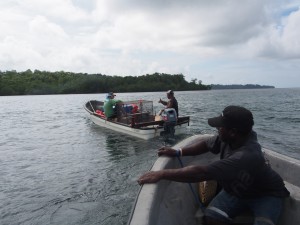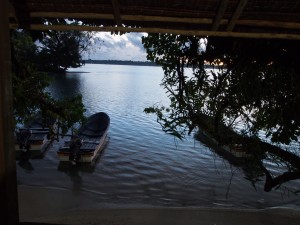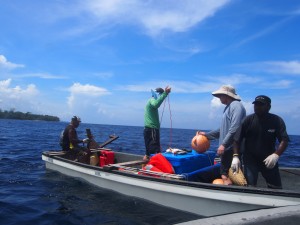Part 3-Search for the Fuzzy Nautilus
On the first day, we deployed one baited trap and one BRUVS. We only deployed one of each because this was a new survey area and until we get a better sense of the bathymetry of the ocean floor (what the ocean floor looks like), we error on the side of caution. So, if we happen to lose something, we only lose one set of gear… We deployed our gear at dusk and left it out overnight. We used a depth finder to set our gear at about 300-350 meters (about 1000-1150 feet). This is prime nautilus habitat in other areas and allows us to compare 300 meters here to 300 meters in the Philippines or Australia. Peter usually managed the depth finder and when he said the correct depth, we tossed in the baited traps and BRUVS. It takes about 30 minutes to reach the bottom. Then we tied on a buoy and crossed our fingers that it would be there the next day.
Deploying the gear is really the easiest part of our work. But the first time is always fun and enjoyable because at this point it finally felt like we were collecting data and starting our search for the fuzzy nautilus.
Needless to say, we were all very happy and excited to come back the next morning and find out what we caught…
This is my seventh research expedition and after seven trips, you’d think I could get a good night’s sleep on the first night and not worry about gear being lost… Nope! So, bright and early at 5:00AM we are up. Remember antimalarial pills. Grab some coffee and food and get on a boat to pull up our gear.
It was only about a 15 minute boat ride to our two buoys. STILL THERE! It takes about 60 minutes to pull the trap and BRUVS up from the depths. There is no mechanical winch. There is no secret. We pulled the gear up with a man powered winch and a lot of muscles.
After the long pulling and tired muscles, we only were able to pull up the baited trap. And it was empty. We started to pull up the BRUVS and had a ‘snag’. The BRUVS were stuck on something on the bottom of the ocean, over 1000 feet below us. We’ve had a few instances where traps and BRUVS have gotten stuck on the bottom but in all those cases, we were able to eventually pull it up. Not this time.
We tried for hours to pull up the BRUVS. We used a boat to try and pry it from whatever it was stuck on. Maybe some huge octopus, aka, the kraken, had it in its grasp and would not let go for anything. We left for the day and came back the next day. This time we attached a huge hook to a stronger line and slide it down the main BRUVS line hoping to hook the BRUVS frame and rip it from the kraken’s grasp with the boat. This didn’t work either. As I write this, our BRUVS still sits at the bottom of the ocean with the kraken staring up and laughing at us silly humans.
Time to take a step back, reassess, and get ready for tomorrow.





